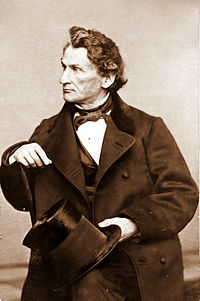J.D. Dana
| James Dwight Dana | |
|---|---|

Dana in 1865
|
|
| Born |
February 12, 1813 Utica, New York |
| Died | April 14, 1895 (aged 82) New Haven, Connecticut |
| Nationality | United States |
| Fields | geology, mineralogy, zoology |
| Influences |
Benjamin Silliman Amos Eaton |
| Signature | |
James Dwight Dana FRS FRSE (February 12, 1813 – April 14, 1895) was an American geologist, mineralogist, volcanologist, and zoologist. He made pioneering studies of mountain-building, volcanic activity, and the origin and structure of continents and oceans around the world.
Dana was born February 12, 1813 in Utica, New York. His father was merchant James Dana (1780–1860), and mother was Harriet Dwight (1792–1870). Through his mother he was related to the Dwight New England family of missionaries and educators including uncle Harrison Gray Otis Dwight and first cousin Henry Otis Dwight. He showed an early interest in science, which had been fostered by Fay Edgerton, a teacher in the Utica high school, and in 1830 he entered Yale College in order to study under Benjamin Silliman the elder. Graduating in 1833, for the next two years he was teacher of mathematics to midshipmen in the Navy, and sailed to the Mediterranean while engaged in his duties.
In 1836 and 1837 he was assistant to Professor Silliman in the chemical laboratory at Yale, and then, for four years, acted as mineralogist and geologist of the United States Exploring Expedition, commanded by Captain Charles Wilkes, in the Pacific Ocean. His labors in preparing the reports of his explorations occupied parts of thirteen years after his return to America in 1842. His notebooks from the four years of travel contained fifty sketches, maps, and diagrams, including views of both Mount Shasta and Castle Crags. Dana's sketch of Mount Shasta was engraved in 1849 for publication in the American Journal of Science and Arts (which Silliman had founded in 1818), along with a lengthy article based on Dana's 1841 geological notes. In the article he described in scientific terms the rocks, minerals, and geology of the Shasta region. As far as is known, his sketch of Mount Shasta became the second view of the mountain ever published.
...
Wikipedia
